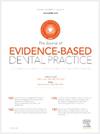AI-AIDED VOLUMETRIC ROOT RESORPTION ASSESSMENT FOLLOWING PERSONALIZED FORCES IN ORTHODONTICS: PRELIMINARY RESULTS OF A RANDOMIZED CLINICAL TRIAL
IF 4
4区 医学
Q1 DENTISTRY, ORAL SURGERY & MEDICINE
引用次数: 0
Abstract
Introduction
External apical root resorption (EARR) is an undesirable loss of hard tissues of the tooth root frequently affecting to the maxillary incisors. The magnitude of orthodontic forces is a major treatment-related factor associated with EARR occurrence in orthodontics. The primary aim of the present randomized clinical trial was (i) to quantify the impact of a sequence of personalized force archwires on EARR compared to the conventional standard of care and (ii) compare the 3D-quantification of EARR using two quantification methods (manual or automated AI-aided segmentation).
Material and Methods
A superiority two arms-parallel-randomized clinical trial (RCT) was conducted to quantify the EARR of two regime forces [CONSORT-guidelines]. A total of 18/43 patients were randomly assigned [block-size: 4] to Control Group [Ni-Ti archwires sequence] or Experimental Group [selective individualized force archwires]. After 142 days sectorial CBCT were obtained; upper incisors were segmented manually and with AI and the volume/length of root quantified. Method error/descriptive statistics (mean; SD; range) and Student t-test were used to assess the differences between groups (Post hoc adjustment for confounders [95% CI; P < .05]).
Results
The total root volume loss detected by AI was 2.44 ± 6.59 mm3 / 2.42 ± 4.75 mm3 (P > .05) and the mean root length loss was 0.20± 0.23mm/0.42 ± 0.43 mm (P = .045) for control/test group, respectively. Despite length loss showed similar changes when it was quantified with both methods, manual and automatic segmentations (P > .05), differences are observed at volume loss. The results demonstrated greater volume loss detection with manual segmentation than with AI-aided segmentation at the global level, volume by thirds, and 4 mm from the apex. However, as we approached apically, the differences equalized and even diminished, resulting in a greater loss with automatic segmentation 1 mm from the apex in the EG (P = .011).
Conclusions
A non direct-force-dependent effect over EARR (6 months) was observed. Individualized force induces slightly higher root resorption at the apical third at 1-2 mm.
人工智能辅助量测牙根吸收评估:一项随机临床试验的初步结果
外根尖吸收(EARR)是一种常见的影响上颌门牙的牙根硬组织损失。正畸力的大小是正畸中发生EARR的主要治疗相关因素。本随机临床试验的主要目的是:(i)量化与传统护理标准相比,一系列个性化力弓线对EARR的影响;(ii)使用两种量化方法(手动或自动人工智能辅助分割)比较EARR的3d量化。材料和方法进行了一项优势双臂平行随机临床试验(RCT),以量化两种政权力量的EARR [conder -guidelines]。18/43例患者被随机分为对照组[镍钛弓丝序列]和实验组[选择性个体化弓丝]。142天后,获得局部CBCT;人工人工智能分割上切牙,量化牙根体积/长度。方法误差/描述性统计(均值;SD;范围)和学生t检验用于评估组间差异(混杂因素的事后调整[95% CI;P & lt;. 05])。结果人工智能检测到的总根体积损失为2.44±6.59 mm3 / 2.42±4.75 mm3 (P >;对照组和试验组的平均根长损失分别为0.20±0.23mm/0.42±0.43 mm (P = 0.045)。尽管长度损失在人工和自动分割两种方法量化时表现出相似的变化(P >;0.05),在体积损失处观察到差异。结果表明,与人工智能辅助分割相比,人工分割在全局水平、体积三分之一和距离顶点4mm处检测到更大的体积损失。然而,当我们接近顶点时,差异平衡甚至减少,导致更大的损失,在EG中从顶点自动分割1毫米(P = 0.011)。结论在6个月的EARR期间观察到非直接力依赖效应。个体化力在根尖三分之一处1-2 mm处引起稍高的根吸收。
本文章由计算机程序翻译,如有差异,请以英文原文为准。
求助全文
约1分钟内获得全文
求助全文
来源期刊

Journal of Evidence-Based Dental Practice
DENTISTRY, ORAL SURGERY & MEDICINE-
CiteScore
6.00
自引率
16.70%
发文量
105
审稿时长
28 days
期刊介绍:
The Journal of Evidence-Based Dental Practice presents timely original articles, as well as reviews of articles on the results and outcomes of clinical procedures and treatment. The Journal advocates the use or rejection of a procedure based on solid, clinical evidence found in literature. The Journal''s dynamic operating principles are explicitness in process and objectives, publication of the highest-quality reviews and original articles, and an emphasis on objectivity.
 求助内容:
求助内容: 应助结果提醒方式:
应助结果提醒方式:


